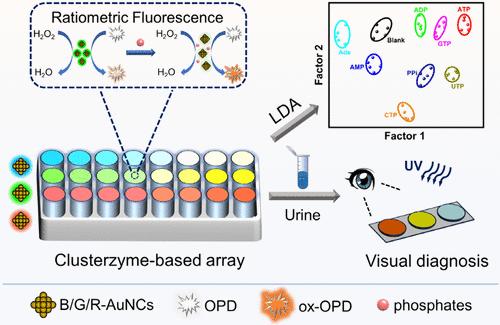当前位置:
X-MOL 学术
›
Anal. Chem.
›
论文详情
Our official English website, www.x-mol.net, welcomes your
feedback! (Note: you will need to create a separate account there.)
Multicolor Gold Clusterzyme-Enabled Construction of Ratiometric Fluorescent Sensor Array for Visual Biosensing
Analytical Chemistry ( IF 6.7 ) Pub Date : 2024-11-15 , DOI: 10.1021/acs.analchem.4c04701 Xiaomeng Zhou, Saijin Huang, Wenfeng Guo, Wenfeng Liu, Mengyao Wen, Li Shang
Analytical Chemistry ( IF 6.7 ) Pub Date : 2024-11-15 , DOI: 10.1021/acs.analchem.4c04701 Xiaomeng Zhou, Saijin Huang, Wenfeng Guo, Wenfeng Liu, Mengyao Wen, Li Shang

|
The simultaneous detection of multiple bioanalytes with similar structures has been a long-standing challenge for biological research and disease diagnosis. Bioreceptor-inspired sensor arrays provide an attractive and competitive solution for addressing this challenge, but applying this technique to biosensing in practical application scenarios is complicated by many factors such as the lack of robust probes, interference from the biological matrix, and difficulty for on-site analysis. In this work, by taking advantage of the intrinsic fluorescence and enzyme-mimic properties of gold nanoclusters (AuNCs), we report the design of an innovative ratiometric sensor array toward enhanced fluorescent visual biosensing. With biologically important phosphates as an example, we show that the present fluorescent clusterzyme-based ratiometric sensor array could effectively discriminate and detect eight types of phosphates. In particular, AuNCs with three different emission colors (blue, green, and red) and good peroxidase-mimic properties were employed as the sensing units, and the presence of phosphates affected both the intrinsic fluorescence and the enzymatic activity of these AuNCs, yielding distinct optical responses in a ratiometric manner. Moreover, a portable sensor array was established by further integrating these fluorescent clusterzymes into a hydrogel matrix, which could visually identify different phosphates based on their distinct fluorescence color changes. Consequently, the point-of-care diagnosis of urinary tract infections at different levels was achieved by analyzing urinary microbial ATP via the present strategy. This study illustrates the great potential of clusterzyme-based fluorescent sensor arrays as a promising biosensing platform for disease diagnosis.
中文翻译:

用于视觉生物传感的基于多色金 Clusterzyme 的比率荧光传感器阵列构建
同时检测具有相似结构的多种生物分析物一直是生物学研究和疾病诊断面临的长期挑战。受生物受体启发的传感器阵列为应对这一挑战提供了一种有吸引力且有竞争力的解决方案,但在实际应用场景中将这种技术应用于生物传感会因许多因素而变得复杂,例如缺乏强大的探针、来自生物基质的干扰以及现场分析的困难。在这项工作中,通过利用金纳米簇 (AuNCs) 的固有荧光和酶模拟特性,我们报道了一种创新的比率传感器阵列的设计,以增强荧光视觉生物传感。以具有生物学重要性的磷酸盐为例,我们表明目前基于荧光团簇酶的比率传感器阵列可以有效地区分和检测八种类型的磷酸盐。特别是,具有三种不同发射颜色 (蓝色、绿色和红色) 和良好的过氧化物酶模拟特性的 AuNC 被用作传感单元,磷酸盐的存在影响了这些 AuNC 的内在荧光和酶活性,以比率方式产生不同的光学响应。此外,通过将这些荧光簇酶进一步整合到水凝胶基质中,建立了一个便携式传感器阵列,该基质可以根据不同的荧光颜色变化直观地识别不同的磷酸盐。因此,通过本策略分析尿液微生物 ATP 实现了不同水平尿路感染的即时诊断。这项研究说明了基于 clusterzyme 的荧光传感器阵列作为一种有前途的疾病诊断生物传感平台的巨大潜力。
更新日期:2024-11-16
中文翻译:

用于视觉生物传感的基于多色金 Clusterzyme 的比率荧光传感器阵列构建
同时检测具有相似结构的多种生物分析物一直是生物学研究和疾病诊断面临的长期挑战。受生物受体启发的传感器阵列为应对这一挑战提供了一种有吸引力且有竞争力的解决方案,但在实际应用场景中将这种技术应用于生物传感会因许多因素而变得复杂,例如缺乏强大的探针、来自生物基质的干扰以及现场分析的困难。在这项工作中,通过利用金纳米簇 (AuNCs) 的固有荧光和酶模拟特性,我们报道了一种创新的比率传感器阵列的设计,以增强荧光视觉生物传感。以具有生物学重要性的磷酸盐为例,我们表明目前基于荧光团簇酶的比率传感器阵列可以有效地区分和检测八种类型的磷酸盐。特别是,具有三种不同发射颜色 (蓝色、绿色和红色) 和良好的过氧化物酶模拟特性的 AuNC 被用作传感单元,磷酸盐的存在影响了这些 AuNC 的内在荧光和酶活性,以比率方式产生不同的光学响应。此外,通过将这些荧光簇酶进一步整合到水凝胶基质中,建立了一个便携式传感器阵列,该基质可以根据不同的荧光颜色变化直观地识别不同的磷酸盐。因此,通过本策略分析尿液微生物 ATP 实现了不同水平尿路感染的即时诊断。这项研究说明了基于 clusterzyme 的荧光传感器阵列作为一种有前途的疾病诊断生物传感平台的巨大潜力。


















































 京公网安备 11010802027423号
京公网安备 11010802027423号